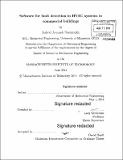Software for fault detection in HVAC systems in commercial buildings
Author(s)
Deshmukh, Suhrid Avinash
DownloadFull printable version (15.35Mb)
Other Contributors
Massachusetts Institute of Technology. Department of Mechanical Engineering.
Advisor
Leon Glicksman.
Terms of use
Metadata
Show full item recordAbstract
The building sector of the United States currently consumes over 41% of the United States primary energy supply. Estimates suggest that between 5 and 30% of any building's annual energy consumption is unknowingly wasted due to pathologically malfunctioning lighting and comfort conditioning systems. This paper presents analytical methods embodied within useful software tools to quickly identify and evaluate those building system faults that cause large building energy inefficiencies. The technical contributions of this work include expert rules that adapt to HVAC equipment scale and operation and methods for sorting fault signals according to user-defined interests such as annual cost of energy inefficiencies. These contributions are particularly unique in their treatment of model and the careful consideration of user interests in fault evaluation. As a first step to developing this general framework for fault detection, first order faults such as simultaneous heating and cooling and imbalanced airflows within several large air-handling units were targeted. Savings of around $22,500 were predicted when the fault of simultaneous heating and cooling was occurring over the entire month in an air handler. Some of the other faults include the heat recovery pump operation in air handling units. An example of the potential energy savings in a large hospital that has been monitored is presented. Yearly savings of around $24,000 were predicted by correcting the operation of the heat recovery pump. Faults in the cooling system were also explored. The paper presents a strategy to load multiple centrifugal chillers with a monotonically increasing COP vs. partload ratio curve. The paper also considers the optimization of cooling tower fan operation coupled with the chiller operation. Models for cooling tower performance and chiller performance are used to define the operation that yields the minimum energy consumption of the system. The number of cooling tower fans and the use of multiple towers with a single chiller are considered. The optimum operation is compared to actual operations to signal operating faults. User testing and experiments show that embracing uncertainty within HVAC fault detection and evaluation is not only paramount to judicious fault inference but it is also central to gaining the trust and buy-in of system users who ultimately can apply fault detection information to actually fix and improve building operations.
Description
Thesis: S.M., Massachusetts Institute of Technology, Department of Mechanical Engineering, 2014. Cataloged from PDF version of thesis. Includes bibliographical references (pages 135-138).
Date issued
2014Department
Massachusetts Institute of Technology. Department of Mechanical EngineeringPublisher
Massachusetts Institute of Technology
Keywords
Mechanical Engineering.